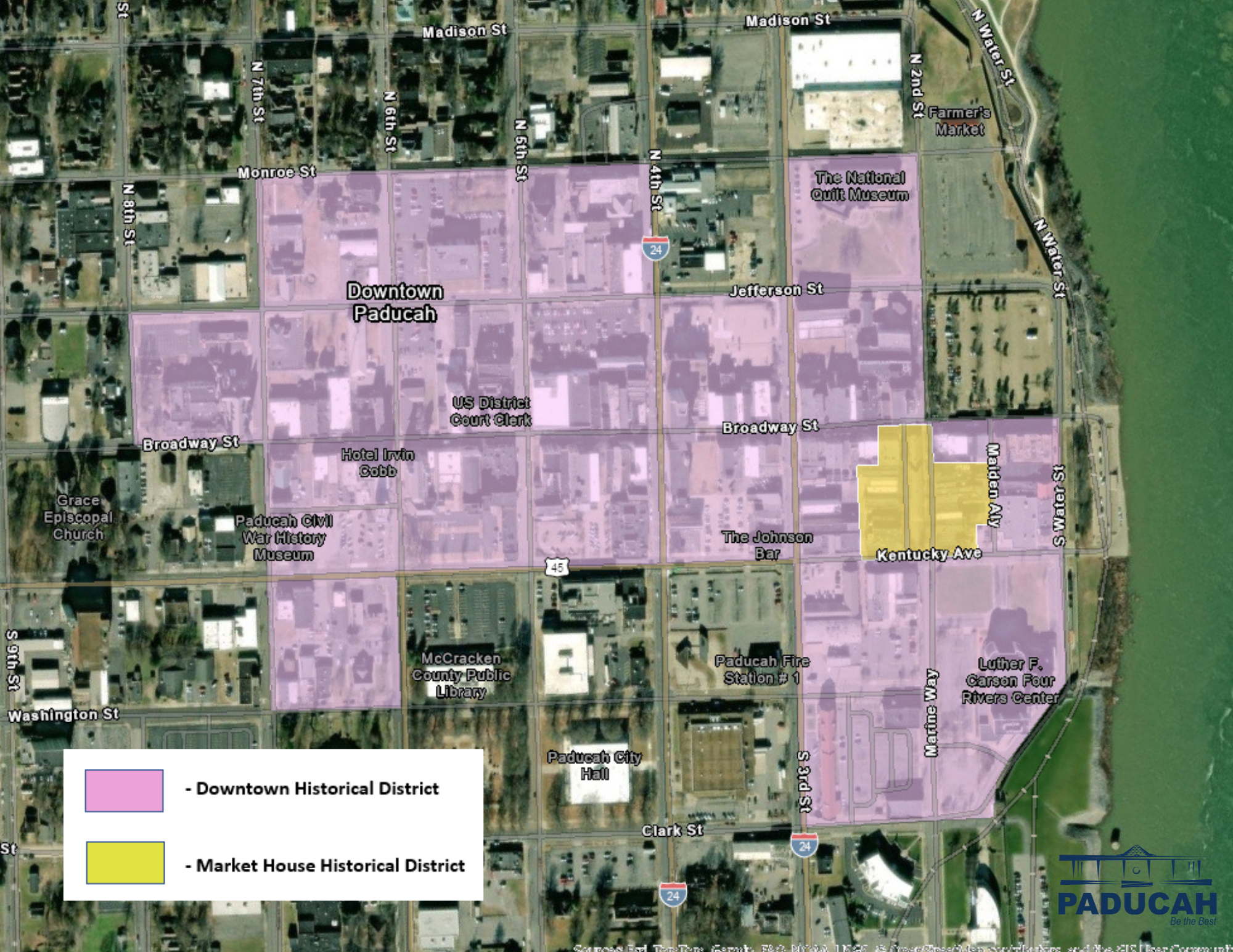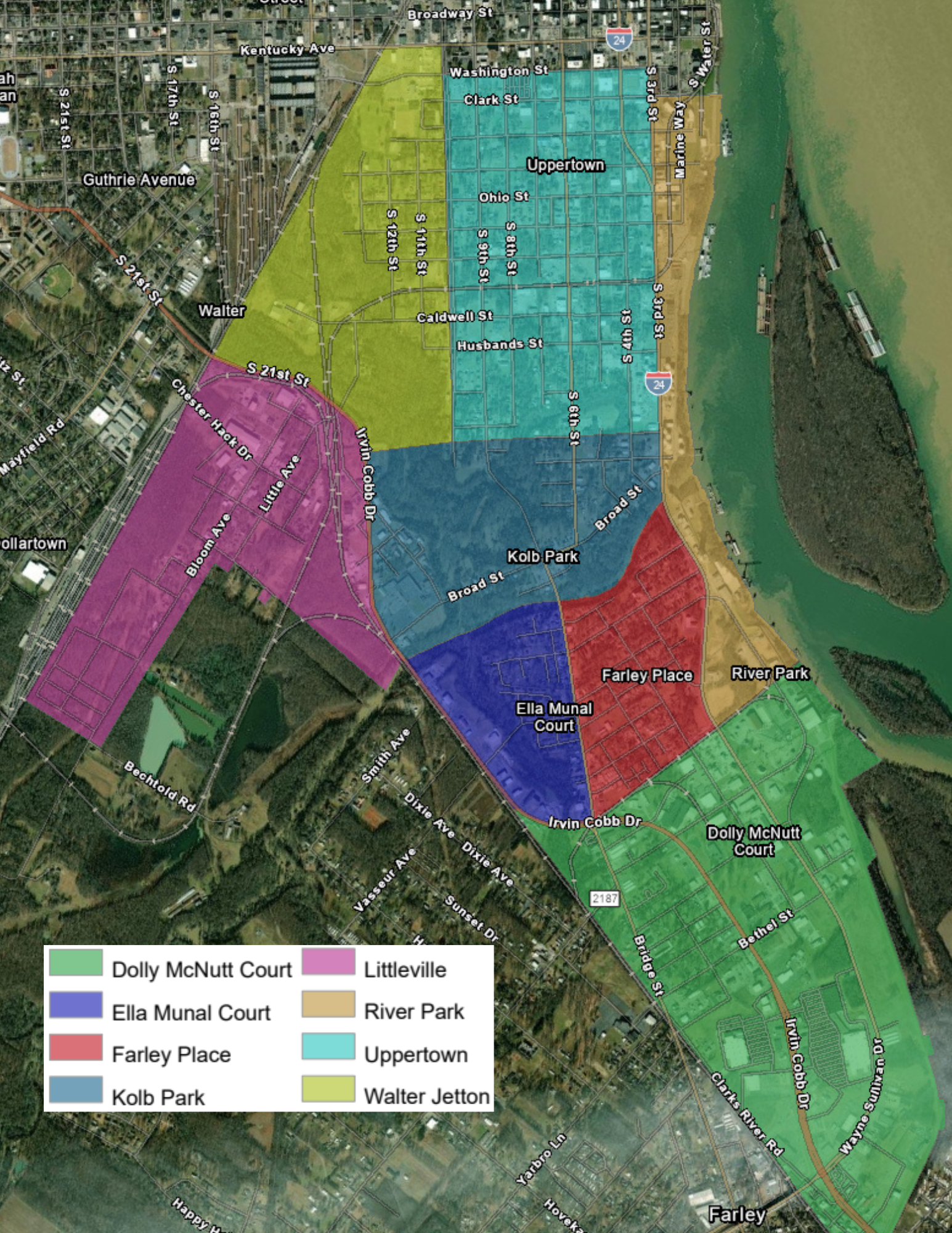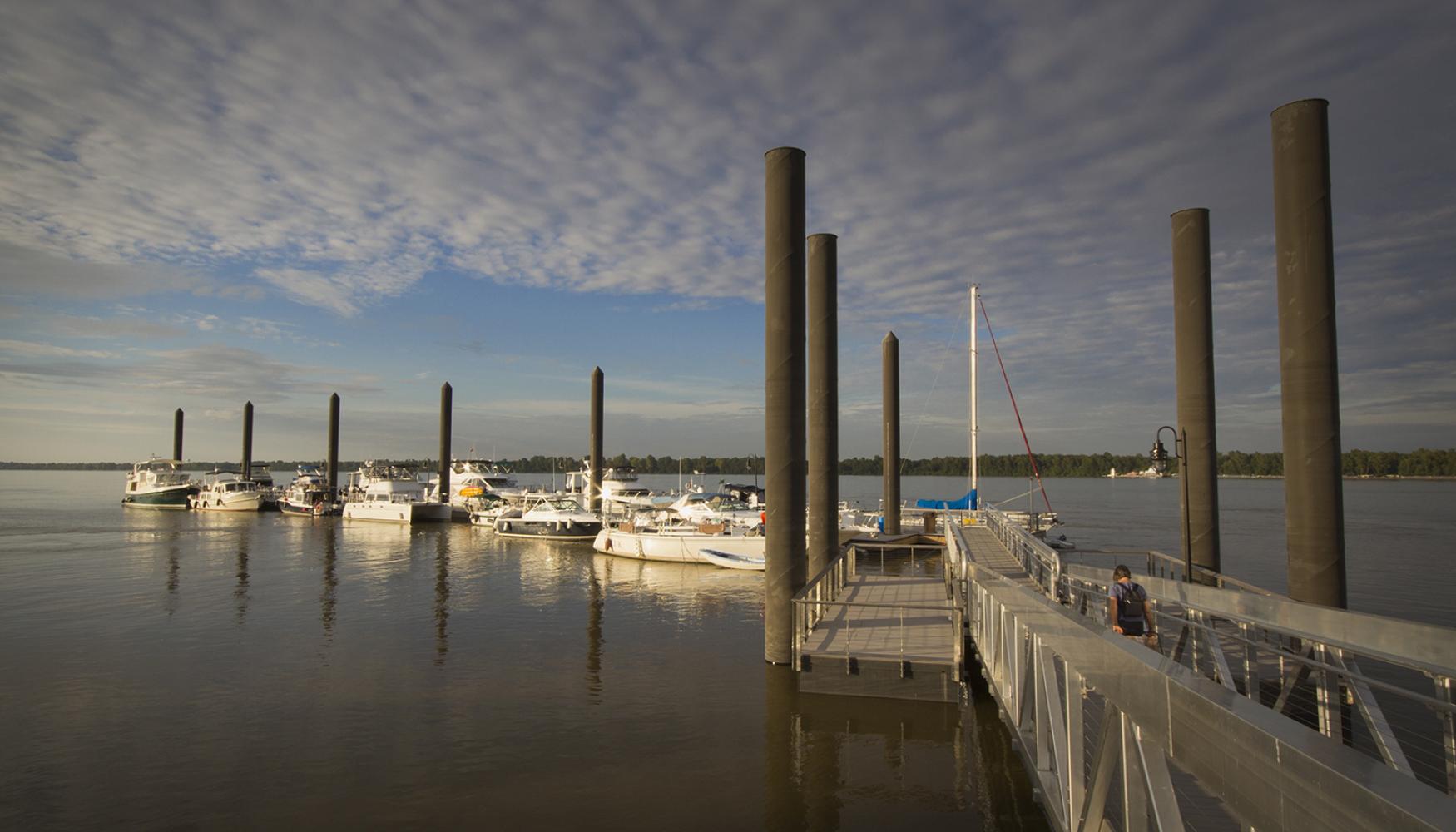Contact
Program Overview
In 2024, the city of Paducah accepted the National Park Service Paul Bruhn Historic Revitalization Grant. The goal of the grant program is to foster economic development in rural communities through the rehabilitation of local historic buildings and resources. The intent of this program is to subaward federal funds to projects that have been selected through a locally administered competitive process as to best suit the needs of the community.
There are three immediate outcomes we hope to achieve with this grant. These include stabilization for buildings where needed, improvement to the structural integrity of the buildings, and the use of this funding to leverage and potentially stack additional financial resources for complete restoration. The subawards will serve as an effort to promote community revitalization and stimulate economic growth and vitality, in addition to enriching cultural tourism. Community reinvestment utilizing historic preservation practices improves community economic health by fostering renewed interest in shopping, working, and living downtown and in the Southside neighborhoods.
The total funding available for subawards is $650,000. Awards will be granted for projects that range from $50,0000 to $100,000. This is a reimbursement grant. The subaward will be paid only upon completion of the work described in the approved scope of work. This scope of work will be outlined in the grant agreement to be executed upon selection of the subaward recipients.
Submit an Application
Dates and Application Portal
The grant application portal opened on Monday, May 19, 2025. The due date for applications is 4:30 p.m. CST on Thursday, July 3. Applications received past the deadline will not be reviewed.
Once you click the link to the application portal, look under “Apply for Incentive Grants" or search “Paul Bruhn Grant” in the search bar.
Apply for Paul Bruhn Historic Revitalization Subgrant
Required Application Attachments
The following attachments are necessary to be included in each application for it to be considered complete. The Proposal Narrative Questionnaire and Budget Narrative Worksheet attachments are provided as downloads for the applicant’s use.
- Proposal Narrative Questionnaire
- Budget Narrative Worksheet
- Contractor Estimate
- Drawings/Renderings
- Photographs – Building Exterior
- Photographs- Proposed Work Area
Informational Workshops for Technical Assistance
The City of Paducah is offering two workshops to provide applicants technical assistance in completing the grant application. These workshops are free, open to the public, and not mandatory to attend. Each workshop will consist of a presentation from City staff on the program’s eligibility requirements, application, and review process. A question and answer opportunity will follow the presentation.
- Thursday, May 29 - 11 a.m. at City Hall (300 South 5th Street, 2nd Floor Commission Chambers)
- Tuesday, June 10 - 6 p.m. in the Market House Event Space (202 Kentucky Avenue)
This material was produced with assistance from the Historic Preservation Fund, administered by the National Park Service, Department of the Interior under Grant Number P24AP02344-00. Any opinions, findings, and conclusions or recommendations expressed in this material are those of the author(s) and do not necessarily reflect the views of the Department of the Interior.
Program Guidelines
- Overview
-
Visit the sections below for details on eligibility, program areas, what is funded and not funded, definitions, cost share/matching funds, application guidelines, and grant selection criteria.
- Eligibility
-
In order to be eligible for this grant, the property must meet the following requirements:
All properties awarded subgrants through this program must be listed in the National Register of Historic Places by the end of the grant period. Properties may be listed individually or identified as contributing to a listed historic district. Properties that have been designated National Historic Landmarks are considered listed in the National Register.
Properties that are not yet listed in the National Register may be awarded subgrants if they have been determined eligible for listing by the State Historic Preservation Office at the time the subgrant is awarded. These properties must be listed in the National Register by the end of the prime grant period.
- Eligible buildings include commercial, multi-unit residential, mixed use (commercial and residential), education, churches, and non-profit.
- The target areas for this program include the Market House Historical District, Paducah Downtown Historical District, and the Southside Neighborhoods. Buildings in each Historical District must be of contributing status to the district. Buildings located in the Southside Neighborhoods must either be on the National Register of Historic Places or eligible for the National Register. Any building chosen that is eligible for the National Register must complete the application process prior to completion of their award. The current status of placement on the National Register can be found on the Kentucky Heritage Council's website.
- All work must meet the Secretary of the Interior's Standards for Rehabilitation.
- As required by the National Historic Preservation Act, all properties receiving funding must enter into a preservation easement agreement with the Kentucky Heritage Council, State Historic Preservation Office. The term of the agreement is a minimum of 10 years as determined by the amount of the subgrant.
- All subawards must follow Office of Management and Budget (OMB) regulations in Title 2, Part 200 of the Code of Federal Regulations (2 CFR 200). In addition, grants must follow the regulations in the Historic Preservation Fund Grant Manual - Historic Preservation Fund (U.S. National Park Service) (nps.gov).
- All properties must be for rehabilitation of existing buildings. New construction of buildings on vacant property will not be eligible.
- Grant-funded work may be a portion of a larger-scale in-progress project. However, grant recipients are only eligible to receive reimbursement for work outlined in the scope of work of the grant agreement. All grant-funded work must be completed within the term of the grant agreement. Reimbursement is not retroactive for work already underway or already completed at the time the grant agreement is signed.
- Program Areas
-
The following maps detail the eligible program areas.
1. Top Map - Downtown and Market House Historical Districts
2. Bottom Map - Southside Paducah Neighborhoods


- What is Funded
-
The following projects are eligible for funding:
- Building stabilization
- Improving the structural integrity of a building
- Façade improvements
- Roofs
- Improving ADA accessibility
- Electrical and plumbing upgrades/repairs
- HVAC
- Historic Wood Doors and Windows (Replacement of restorable historic wood doors and windows. Repair/restoration is preferable to replacement. If replacement occurs, it is almost always best to use traditional historic materials. Only in extreme circumstances will projects that include replacement elements consisting of non-historic materials be considered.)
- What is Not Funded
-
The following projects or items are NOT eligible to receive funding:
- Construction of new buildings (this includes accessory buildings such as garages and storage buildings).
- Individual residences/single family homes.
- Acquisition of collections or historic sites.
- Projects where the entire scope of work consists of routine or annual maintenance.
- Conservation of collections.
- Long-term maintenance or curatorial work beyond the grant period.
- Reconstructing historic properties (recreating all or a significant portion that no longer exists).
- Moving historic properties or work on moved historic properties that are no longer eligible for listing in the NRHP.
- Cash reserves, endowments, revolving funds, or fund-raising costs.
- Work performed prior to announcement of award.
- Work on sites owned by the National Park Service.
- Lobbying or advocacy activities.
- Costs for work already completed or funded through other federal programs.
- Exterior siding and decorative elements that are non-historic or historically inappropriate in both material and design.
- Landscaping, streetscaping, parking lots, paving, fences, and gazebos.
- Miscellaneous costs, contingencies, reserves, and overhead.
- Furniture, fixtures, and equipment (interior or exterior).
- Electronic security systems.
- Exterior security measures that detract from the historic character of the building, such as burglar bars or roll-up grills.
- Changes required from property maintenance alerts issued by City of Paducah Fire Prevention Division and Code Enforcement.
- Definitions
-
A comprehensive list of definitions related to this program and application process can be found in the document below.
- Cost Share/Matching Funds
-
All applicants will be required to submit a minimum of a 10% cash match for the requested funds. For example, if the total amount of funding required for the applicant’s project is $100,000, the applicant will be responsible for $10,000 of that amount and may request $90,000 in awarded funds. Any funding received from the City of Paducah through other grant/contracting methods cannot be used as match.
One of the goals of this project is to increase economic development in the target areas. As such, those applicants that commit a higher amount of matching dollars, will receive additional points in the scoring of their submission, per the chart below:
- 10% Cash Match – 5 points
- 11%-15% - 10 points
- 16%-20% - 15 points
- 21% and above – 20 points
- Application Guidelines
-
- The applicant must be the primary owner of the building or have a notarized document from the primary owner authorizing the application on their behalf.
- The property must be located within the defined program areas.
- The property must be placed on the National Register of Historic Places or eligible to be so within the grant period.
- An entity can only submit ONE application.
- Incomplete applications and applications for buildings that do not meet the qualifications will not be reviewed or scored.
- All grantees must comply with all site visits, inspections, and project-related documentation requirements.
- All grantees must comply with all applicable local, state, and federal regulations and requirements.
- All grantees must complete their projects within the contract period.
- Extensions must be submitted at least 90 days in advance of the original project deadline and are not guaranteed.
- Competition - Grant Selection Criteria
-
It is anticipated that this will be a highly competitive grant application. Regrettably, not every applicant can be assured of receiving a grant. Panelists will review each application and provide an overall score in a range of 0 points to 100 points. Award considerations to be ranked by the panelists include, but are not limited to
- How well the need for the project is described including the history of the building and financial need.
- The applicant’s previous experience with historical revitalization and knowledge of the Secretary of the Interior’s Standards for Rehabilitation.
- The economic impact the completed project will bring to the target area.
- The visual impact the completed project will bring to the target area experience
- The impact of the project on the original building design. Priority will be given to projects that restore the building’s original historic character and best follow the Standards for Rehabilitation.
- Applicant’s amount of cash match included in the project costs.
- Completeness of the application which include
- How well the scope of work is described.
- How well the cost of the work is documented.
- Quality and helpfulness of the supplements (maps, historic documentation, current photographs of the building, photographs that help indicate where work is intended, photographs showing the setting of the building, etc.)
This grant program is being funded by and completed in partnership with the National Park Service. As such, the National Park Service will review and approve all sub-grantees chosen by the City through the application process.
